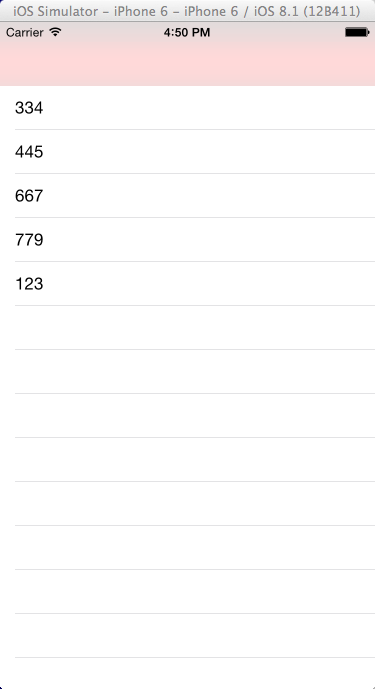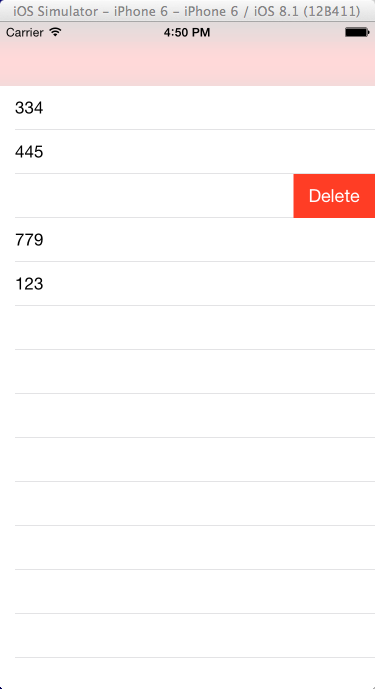最近做项目又开始用到了uitableview,温习之余,在这里把uitableview的用法分享一下,有不对的地方欢迎大家提出来。
废话不多说,先创建一个工程,由于Xcode6,去除了创建工程时的空项目的选项,我们继续选择single view application 在这里我们用不到main storyboard 先删掉,创建一个类,继承自
class="p1">UINavigationController ,这里文件名字叫做HealthViewcont
然后在appdelegate里的
- (BOOL)application:(UIApplication *)application didFinishLaunchingWithOptions:(NSDictionary *)launchOptions {
// Override point for customization after application launch.
return YES;
}
添加如下代码:
self.window = [[UIWindow alloc]initWithFrame:[UIScreen mainScreen].bounds];
[self.window makeKeyAndVisible];
self.window.rootViewController = [[HealthViewcont alloc]init];
准备工作就完成了
-:UITableView的初始化
1.在.h文件里实现 UITableViewDataSource,UITableViewDelegate两个代理协议,如果你这里继承的时UITableView 可以不用写
然后定义两个对象
@property(nonatomic)UITableView* tableview;
@property(nonatomic)NSMutableArray* dataArryList;
在.m文件里实现
@synthesize tableview; @synthesize dataArryList;
2.在viewdidload里添加如下代码
- (void)viewDidLoad { [super viewDidLoad]; //初始化一个tableview tableview = [[UITableView alloc]initWithFrame:CGRectMake(0, 64, [UIScreen mainScreen].bounds.size.width, [UIScreen mainScreen].bounds.size.height-64)]; [self.view addSubview:tableview]; [self.navigationBar setBackgroundColor:[UIColor redColor]]; //实现代理 tableview.delegate = self; tableview.dataSource = self; //初始化数据 dataArryList = [[NSMutableArray alloc]initWithArray:[NSArray arrayWithObjects:@"334", @"445",@"667",@"779",@"123",nil]]; // Do any additional setup after loading the view, typically from a nib. }
到这里初始化就完成了
二:UITableView数据源的初始化
UITableView有三个必须要实现的代理方法
#pragma mark - Table View //设置section的个数 - (NSInteger)numberOfSectionsInTableView:(UITableView *)tableView { return 1; } //设置每个section 的行数 - (NSInteger)tableView:(UITableView *)tableView numberOfRowsInSection:(NSInteger)section { return [dataArryList count]; } //对每个TableViewCell进行操作 UITableView中显示的每一个单元都是一个UITableViewCell对象,其初始化函数initWithStyle:reuseIdentifier:在tableView快速滑动的滑动的过程中,频繁的alloc对象是比较费时的///,于是引入了cell的重用机制 - (UITableViewCell *)tableView:(UITableView *)tableView cellForRowAtIndexPath:(NSIndexPath *)indexPath { static NSString* cellIdentifier = @"cell"; UITableViewCell* cell = [tableView dequeueReusableCellWithIdentifier:cellIdentifier]; if (cell== nil) { cell= [[UITableViewCell alloc] initWithStyle:UITableViewCellStyleDefault reuseIdentifier:cellIdentifier] ; } cell.textLabel.text=[dataArryList objectAtIndex:indexPath.row]; return cell; }
三:插入和删除
- (void)tableView:(UITableView *)tableView commitEditingStyle:(UITableViewCellEditingStyle)editingStyle forRowAtIndexPath:(NSIndexPath *)indexPath { if (editingStyle == UITableViewCellEditingStyleDelete) { [self.dataArryList removeObjectAtIndex:indexPath.row]; [tableView deleteRowsAtIndexPaths:@[indexPath] withRowAnimation:UITableViewRowAnimationFade]; } else if (editingStyle == UITableViewCellEditingStyleInsert) { [self.dataArryList insertObject:@"456" atIndex:indexPath.row]; [tableView insertRowsAtIndexPaths:[NSArray arrayWithObject:indexPath] withRowAnimation:UITableViewRowAnimationRight]; // Create a new instance of the appropriate class, insert it into the array, and add a new row to the table view. } }
四:其他的一些常用操作
//设置UITableView行缩进 -(NSInteger)tableView:(UITableView*)tableView indentationLevelForRowAtIndexPath:(NSIndexPath *)indexPath{ NSUInteger row = [indexPath row]; return row; } //设置cell行间隔的高度 -(CGFloat)tableView:(UITableView *)tableView heightForRowAtIndexPath:(NSIndexPath *)indexPath{ return 60; } //设置选中Cell的响应事件 -(void)tableView:(UITableView*)tableView didSelectRowAtIndexPath:(NSIndexPath *)indexPath{ } //设置选中的行所执行的动作 -(NSIndexPath*)tableView:(UITableView *)tableView willSelectRowAtIndexPath:(NSIndexPath *)indexPath { NSUInteger row = [indexPath row]; return indexPath; } //设置划动cell是否出现del按钮,可供删除数据里进行处理 -(BOOL)tableView:(UITableView *)tableView canEditRowAtIndexPath:(NSIndexPath *)indexPath { } //设置删除时编辑状态 -(void)tableView:(UITableView*)tableView commitEditingStyle:(UITableViewCellEditingStyle)editingStyle forRowAtIndexPath:(NSIndexPath*)indexPath { }
最后看一下运行的效果

